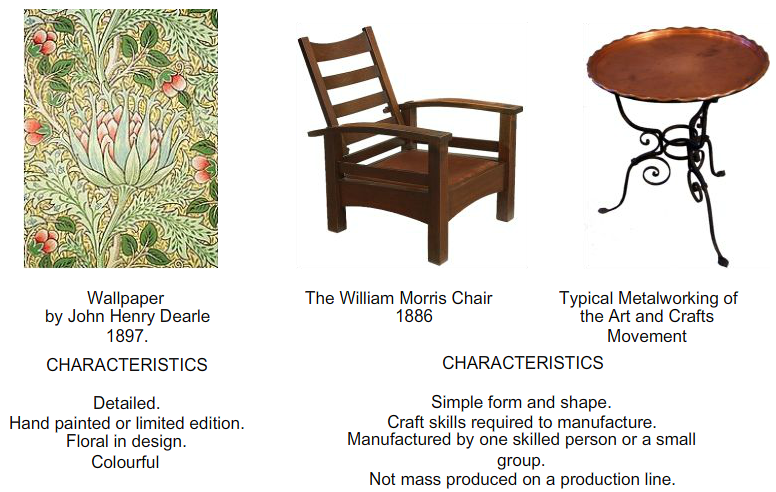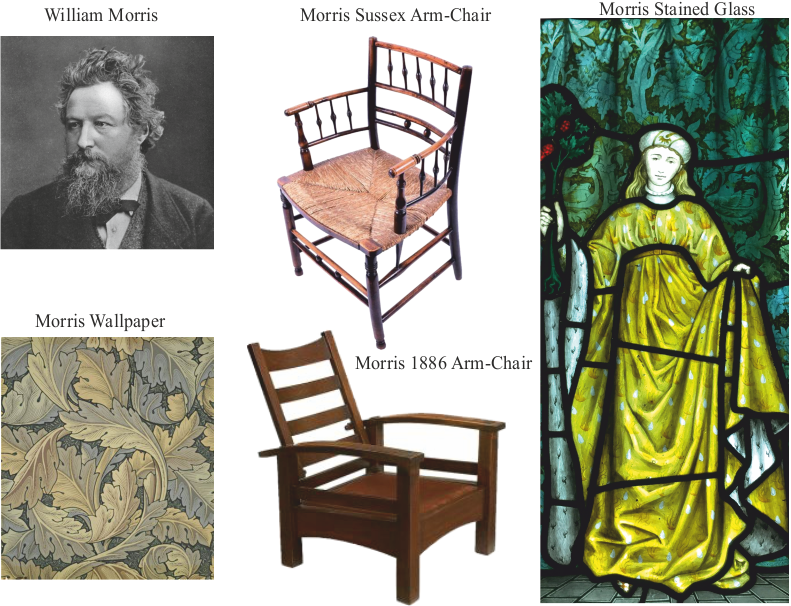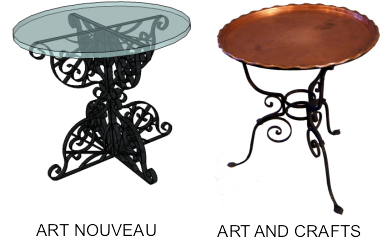| CLICK HERE FOR INDEX PAGE | |
| THE ARTS AND CRAFTS MOVEMENT 1880 to 1910 | |
| V. Ryan © 2007 - 2022 | |
| PDF FILE - CLICK HERE FOR PRINTABLE WORKSHEET | |
|
Those involved in the Arts and Crafts Movement, promoted simple items
(furniture, ornaments etc...) manufactured through good craft techniques.
It was a rebellion against the age of mass production. A return to
traditional craft methods and ‘romantic’ forms of decoration. Products
were to be manufactured by individuals or small groups rather than on a
mass production line. Ornamental objects, floral fabrics, book making,
weaving, jewellery, enamelling, metalwork and ceramics, were all
influenced by the Art and Crafts movement. The Arts and Crafts movement developed from the views of people such as William Morris (1834 - 1896). He was a poet and artist, who believed in a combination simplicity, good design and craft work. He believed that industrially manufactured items lacked the honesty of traditional craft work. His views and opinions were also supported by the artist / influential social intellectual, John Ruskin (1819 - 1900). As the movement grew in influence, architecture, furniture making and the decorative arts, such as interior design, started to display the simplicity and craft approach. The Arts and Crafts Movement supported economic and social reforms as away of attacking the industrialised age. Many Art and Craft associations sprung up in this period such as Home Arts and Industries Association. This association aimed to support and promote rural handicrafts. The Arts and Crafts Exhibition Society, formed in 1887 promoted embroidery, fabrics, upholstery and furniture. The Guild of Handicraft (1888) was another association set up during this time. The philosophy behind the Arts and Crafts movement believed that the industrial revolution had made man less creative as ‘his’ craft skills had been removed from the manufacturing process. One aim of the movement was to put ‘man’ back in to the design and manufacturing process, Craft skills and good honest design would again be central to the manufacturing process. The Arts and Crafts movement influence other art movements such as the Bauhaus and Modernism, movements that believed in simplicity of design. Bauhaus and modernism believed in design and manufacture that the general public could afford. They also believed that simple functional designs should look good and be aesthetically pleasing. Manufactured products should be enjoyed for the way they looked and not only for their functional application. |
|
 |
|
 |
|
|
1. The Art Nouveau movement, encouraged the industrial production of
ornate , highly decorated products. Art Nouveau products were sold to the
rich, to decorate their houses and they can still be seen on public
buildings such as railway stations or monuments, that were constructed in
the nineteenth century.. How did the Arts and Crafts movement differ from Art Nouveau? The key phrases below may help you answer this question. |
|
|
SIMPLE CRAFT WORK MANUFACTURED BY ONE PERSON OR A SMALL GROUP NOT MASS PRODUCTION AFFORDABLE FOR THE GENERAL PUBLIC MANUFACTURED IN SMALL NUMBERS |
|
| 2. What was the underlying social philosophy behind the Arts and Crafts movement? | |
| 3. Name two twentieth century Arts Movements and explain how they were influenced by the Arts and Crafts movement. | |
| NAME 1:________________________________________________ | |
| NAME 2:________________________________________________ | |
| HOW THEY WERE INFLUENCED BY THE ARTS AND CRAFTS MOVEMENT: | |
 |
4. Study the Art Nouveau table and the Arts and Crafts table. How do they
differ in terms of the way they look and how they were manufactured? |
| CLICK HERE FOR PRODUCT DESIGN INDEX PAGE | |